#Amphiprion
Text
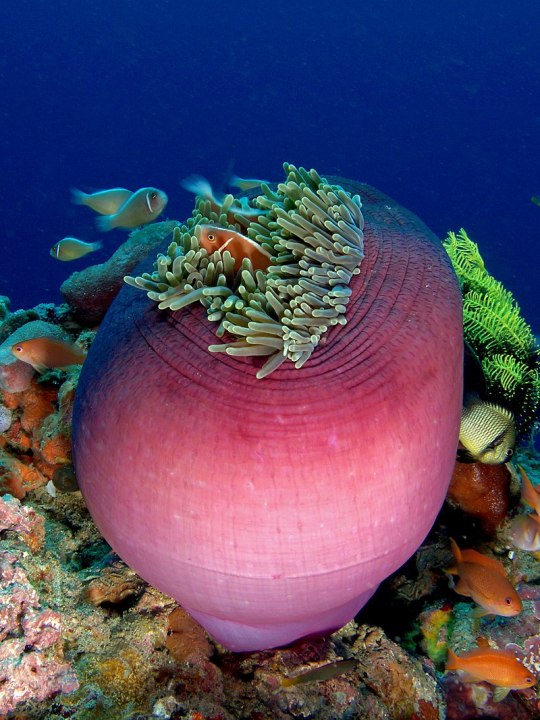
Magnificent Anemone (Heteractis magnifica), family Stichodactylidae, East Timor
with Pink Anemonefish (Amphiprion perideraion), family Pomacentridae
photograph by Nick Hobgood
#anemone#cnidaria#animals#nature#ocean#heteractis#stichodactylidae#asia#fish#anemonefish#amphiprion#ichthyology#pomacentridae
433 notes
·
View notes
Text

NEMO FISHES CAN COUNT STRIPES, SCIENTISTS SAY
Clownfish, aka anemonefish, famous by their distinct white bar patterns seen in Disney’s Finding Nemo, can count up to three, a new study finds.
There around 28 different species of anemonefish know to date, having between 0 to 3 white stripes, which has been suggested to be important for species recognition. In a recent study, researchers found out that in lab conditions, common anemonefish (Amphiprion ocellaris), a species that displays three white bars, when faced with an intruder fish, attacked their own species more frequently than other species of intruding anemonefish.
Recearchers tested how common anemonefish could count number of stripes, and they used orange plastic models with different numbers of bars, and compared whether the frequency of aggressive behavior towards the model differed according to the number of bars. The frequency of aggressive behavior toward the 3-bar model was the same as against living common anemonefishes and was higher than towards any of the other models.

-Plastic models used to measure the aggressive behavior of clown fish. Clownfish could count stripe and shown aggresive behavior following the number of stripe. Photo by Kina Hayashi.
Researchers believe common clowfish count the number of white stripes as a cue to identify and attack only competitors that might use the same anemone where they live, using counting as an important behavior for efficient host defense.
Photo: Gaell Mainguy ·
Reference (Open Access): Hayashi et al., 2024. Counting Nemo: anemonefish Amphiprion ocellaris identify species by number of white bars. Journal of Experimental Biology
#Amphiprion ocellaris#common anemonefish#Amphiprion#science#biology#marine science#marine biology#scieblr#bioblr
80 notes
·
View notes
Photo
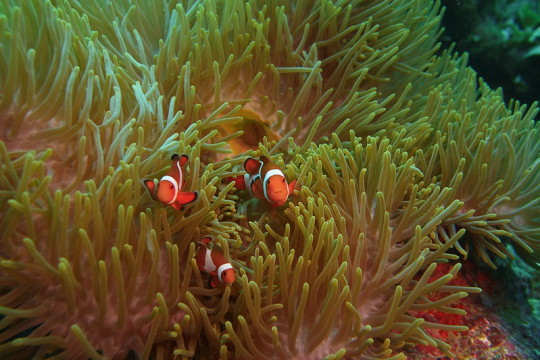
Common clownfish (Amphiprion ocellaris) shelter in an anemone in Panglao, Philippines
by Kary Mar
#common clownfish#anemones#clownfish#bony fish#fish#Amphiprion ocellaris#amphiprion#pomacentridae#actinopterygii#chordata#wildlife: philippines
195 notes
·
View notes
Text

Clown anemonefish (Amphiprion percula) amongst tentacles of a blue variety of anemone (Stichodactyla gigantea)
Photo by Georgette Douwma
#Amphiprion percula#Amphiprion#Stichodactyla gigantea#Stichodactyla#anemone#clownfish#fish#sea anemone#marine#marine life#ocean#sea#blue#orange#blue and orange#orange and blue#animals#nature
8 notes
·
View notes
Text
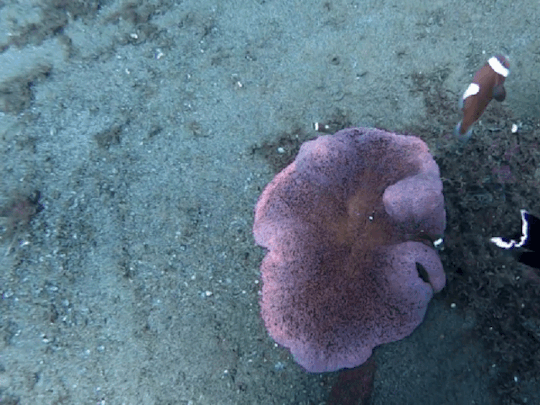
0 notes
Text
Fiji Clownfish
Amphiprion barberi also known as the Fiji Anemonefish or Fiji Clownfish. Spotted off the main island in Fiji.
#scuba #diving #findingnemo #fish #nature #nemo #wildlife #coral #reef #sealife #twitternaturecommunity
Anemonefish or Clownfish are fishes from the subfamily Amphiprioninae in the family Pomacentridae.
Fiji Anemonefish (Amphiprion barberi)
Anemonefish typically live at the bottom of shallow seas in sheltered reefs or in shallow lagoons.
Fiji Anemonefish (Amphiprion barberi)
Anemonefish are endemic to the warmer waters of the Indian Ocean, including the Red Sea, and Pacific Ocean, the Great…

View On WordPress
#Amphiprion barberi#Anemonefish#clownfish#ecotourism#Fiji#Nature#Photography#Underwater Photographs#waidroka bay#wildlife
4 notes
·
View notes
Text
Creature Awaits #243
Each week I plan to feature an amazing creature, admiring God's fantastic artistry. Hopefully it’ll brighten someone’s day to see something new and interesting if they haven’t seen it before. : )
As the Pantone color of the year is "Peach Fuzz", so we'll dive into the second month of this relatively new year by featuring creatures of this cozy, comforting color. : )

(Gorgeous still taken by talented photographer, Christian Gloor (CC BY 2.0 Deed))
The Pink Skunk Clownfish
A.K.A: The Pink Anemonefish
(Yes, despite the name, it's actually more peach in hue. : ) )
Scientific Name: Amphiprion perideraion
Region: Reef lagoons and slopes across the western Pacific and eastern Indian oceans
Size: Up to about 3.9" (~10cm)
Interesting Notes: Unlike many anemonefish species, the Pink Skunk Clownfish, one of the smallest anemonefish, is willing to share its anemone host home with another species. : )
#creatureawaits#beautiful animals#beautiful fish#peach fuzz#Pink Skunk Clownfish#cute animals#Pink Anemonefish#Amphiprion perideraion
1 note
·
View note
Text
Purrling is Almost Fully Stocked!
It's now been a week since I added Moby's mate, Cousteau! Both Moby and Cousteau are clownfish of the species Amphriprion ocellaris, so in the reefing hobby we tend to just call them ocellaris clownfish. (Their other common name, false percula clownfish, is kinda dumb in my opinion given that ocellaris are prettier than percula clowns.) Ocellaris clownfish come in a huuuge range of morphs, all of which were originally found in the wild.
Because they prefer to live in mated pairs and because they don't have any trouble recognizing other ocellaris regardless of their morph, I decided to have a mismatched pair. Moby is a mocha ocellaris; his morph is a slightly darker version of the usual wild type of the species of Finding Nemo fame.
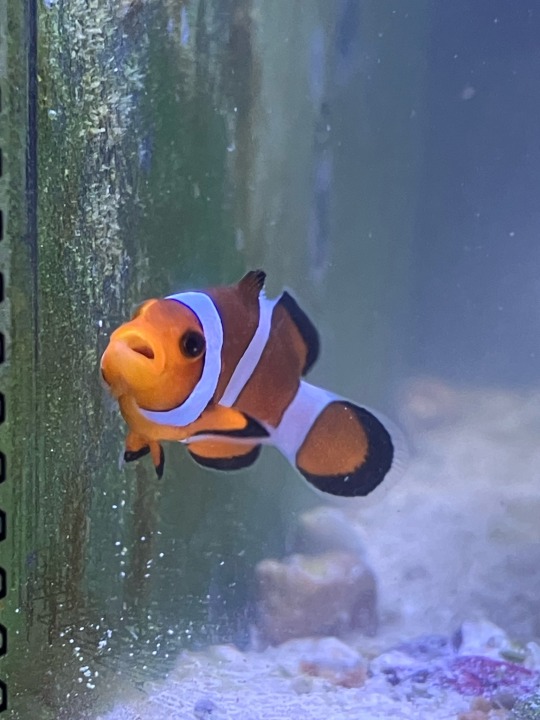
Yes, he was named for the titular character of Moby Dick by my dad.
Cousteau, meanwhile, is a fancier black snowflake. Since he is the smaller of the two he will stay a male (all clownfish are born male,) while Moby will develop into a female. (That's right, folks: clownfish are trans!🏳️⚧️)

Cousteau is named for the father of marine biology and scuba diving, Jacques Cousteau.
Because my fish dealer didn't have any Euphillia hammer coral in stock that were of a morph I want, I also introduced Nickel the neon blue goby (yep, she is named after the IDW II Transformer's DJD's diminutive little medic, Nickel!) Nickel the fish has been shy but thankfully not as much as my yellow watchman goby Clyde who seems determined to spend her entire existence hiding in her den. Maybe she'll come out more once I give her a pistol shrimp.

The beautiful little Nickel, whose function, just like the more famous and larger bluestreak cleaner wrasse, is parasite removal from larger fish. (This kinda makes her a medic just like her namesake!)

The singular good photo that I possess of Clyde, back before my cat Keplar scared the crap out of her somehow and she decided to constantly live in her burrow.
With the addition of Cousteau Purrling Reef's population list of fish is almost complete; the final fish to acquire will be a royal gramma basslet, to be named Amphritite. I also need to get Clyde that pistol shrimp and get a purple pincushion urchin. Then, maybe, (unless I acquire a new cleaner shrimp,) I'll be done adopting ambulatory livestock. I haven't even begun adopting corals however! Here're some of the species I'm hoping to acquire:
- Genus Euphillia: Frogspawn (Yoshi's morph which is green with indigo tentacle tips)
- Genus Euphillia: Hammer (purple with turquoise tentacle tips)
- Favia (arguably not actually Favia as many favia has been reclassified): 'green' (turquoise) and purple morph
- Blastomussa merletti: purple wine morph (it's also purple and turquoise)
- Lepastrea: I'm partial to the blueberry fields morph. I also like the one called polkaroo.
- Possibly some Acans
- Maybe some Cyphastrea. I like the morphs meteor shower, bling bling, seafoam and peppermint.
- Maybe some Duncans; I don't really like duncans though.
- Hard maybe some zoanthids (I'm worried about palytoxin and mine and Keplar's stupidity in regards to sticking parts of our bodies in the water with little thought.)
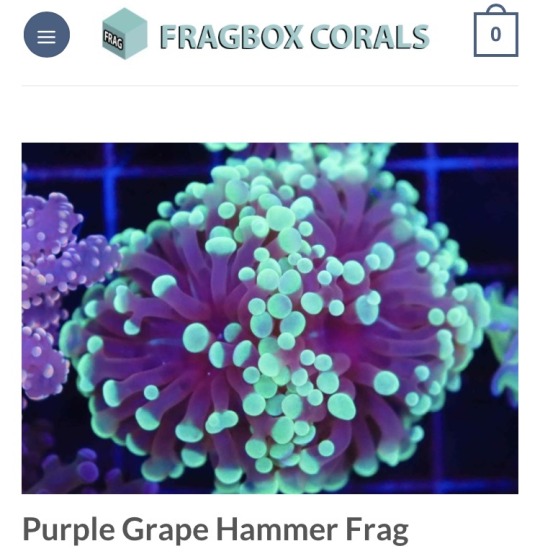
Behold, my dream hammer coral (picture by Fragbox Coral.)
In any case, things are progressing slowly but surely with Purrling Reef. I will hopefully be adding some corals next month; there's a local guy with exactly the frogspawn that I want so I might try to get a frag from him.
Skitter, my intrepid blue-eyed hermit crab bids ye adieu. (He would like you to recognize that crabs are in fact far superior to snails.)
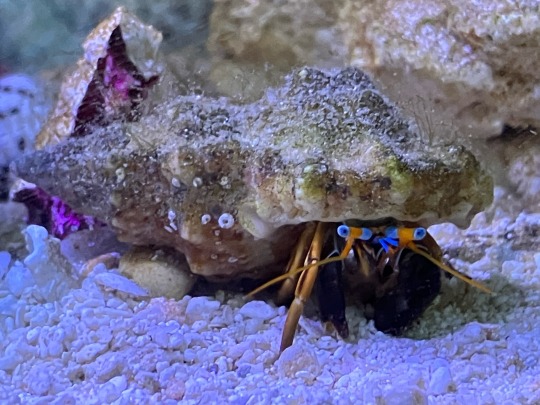
#Purrling Reef#reefing#saltwater aquarium#marine aquarium#clownfish#amphiprion ocellaris#neon blue goby#yellow watchman goby#blue eyed hermit crab#hermit crab
0 notes
Text

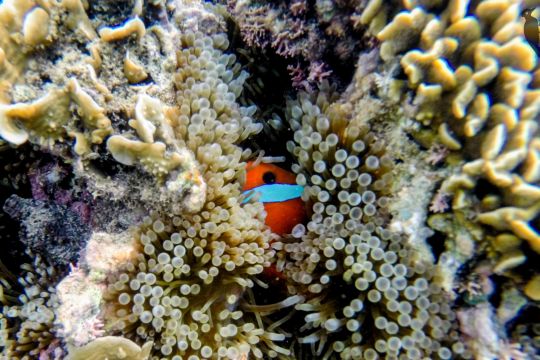
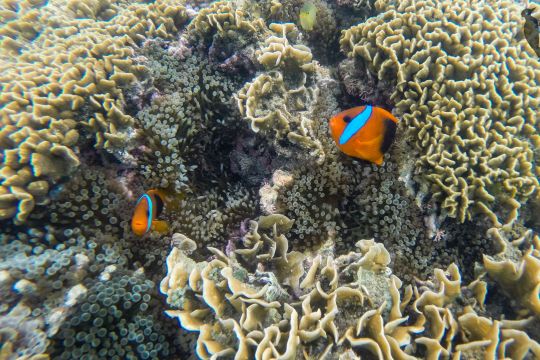
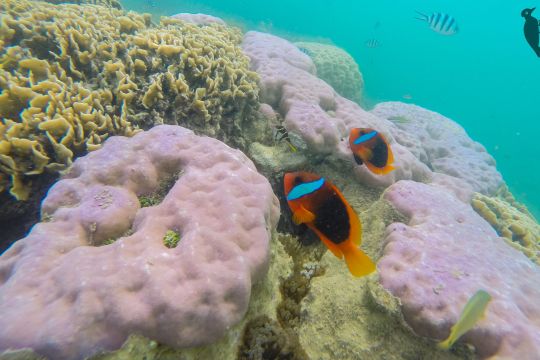
Nouvelle-Calédonie, janvier 2015
Nemo... Poisson-clown de la grande barrière (Amphiprion akindynos)
#nouvelle calédonie#bestiole du monde#Poisson-clown de la grande barrière (Amphiprion akindynos)#calédonie sous l'eau#poisson calédonien
0 notes
Text
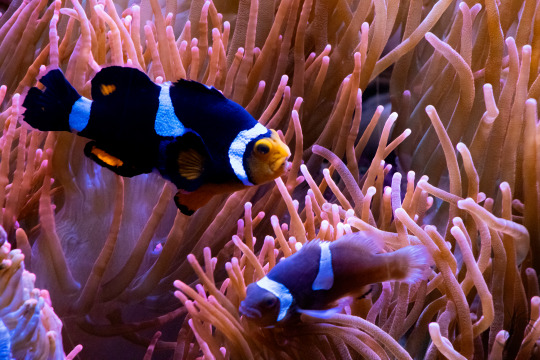
False Percula Clownfish (amphiprion ocellaris)
taken at the Denver Zoo in Denver, Colorado
status: not evaluated
Very neat to be able to share a fish species' name for once! These little fish grow up to 3.5 centimeters long and are rarely more than 39 feet deep. Like other clownfish they have a symbiotic relationship with anemone.
#False Percula Clownfish#clownfish#fish#denver zoo#denver#zoo#Amphiprion ocellaris#colorado#photo#photography#canon#canon 6d mark ii
1 note
·
View note
Text

Magnificent Anemone (Heteractis magnifica), family Stichodactylidae, Maldives
with Blackfoot Anemonefish (Amphiprion nigripes), family Pomacentridae
photograph by Andrew ( Harry ) Harrison
#anemone#cnidaria#ocean#heteractis#stichodactylidae#animals#nature#asia#anemonefish#fish#amphiprion#pomacentridae#ichthyology
111 notes
·
View notes
Video
Bleached anemone with Amphiprion perideraion, pink anemonefish #marineexplorer by John Turnbull
Via Flickr:
There is a small section of unbleached tentacles down the bottom of the pic. One Tree Island, Steve's Bommie
12 notes
·
View notes
Text

An orange skunk clownfish (Amphiprion sandaracinos) in Bohol, Philippines
by François Libert
#orange skunk clownfish#anemone fish#clownfish#bony fish#fish#amphiprion sandaracinos#amphiprion#pomacentridae#actinopterygii#chordata#wildlife: philippines#wildlife: asia
207 notes
·
View notes
Text

Pink anemonefish (Amphiprion perideraion) in closed anemone -
Photo by Juergen Freund
#Amphiprion perideraion#Amphiprion#anemonefish#pink anemonefish#fish#anemone#orange#orange anemone#sea anemone#ocean#sea#marine#marine life#marine animals#wildlife#animals#nature
18 notes
·
View notes
Text
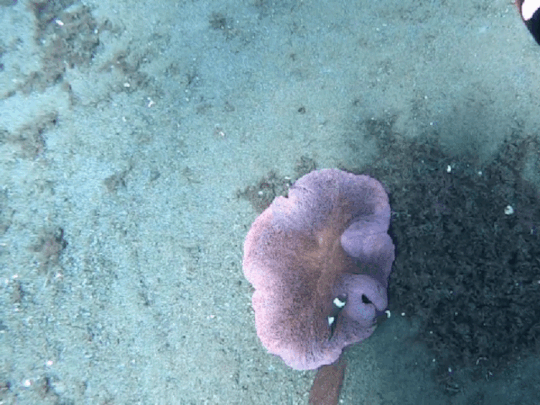
0 notes
Text
Fishy facts (pt.2)
Hey I'm Harrish, these little fellas will make you laugh. Let's get right into it.
The Clownfish(Amphiprioninae). It's likely that anyone with kids and a DVD player believes they are experts on the clownfish, also known as the clown anemonefish. They might be unaware, but the main characters of Finding Nemo are referred to as false anemonefish. Although they are almost similar, true anemonefish, Amphiprion percula, differ slightly in appearance and inhabit distinct environments (National Geography). Did You Know? Clownfish are all male at birth. Some people will change their gender later in life to female. But clownfish won't settle in with any old anemone. Out of over 1,000 species of anemone, only about 10 are acceptable hosts. Clownfish are protected against the stinging nematocysts of anemones by the mucous layer on their skin. Clownfish must first gently contact the tentacles of the anemone to get used to its sting before they can dwell inside of it. The host anemone works to ward off possible predators of clownfish because other fish lack the same covering of mucus that protects them.

Clownfish in anemones.
Clownfish and their environment are in danger due to ocean acidification and climate change. Clownfish find it more difficult to perceive sounds and scents that typically aid in their habitat navigation and predator detection as saltwater becomes more acidic. They might exhibit dangerous actions as a result of this (Ocean Conservancy).
Thank you very much for reading. Nice having a fishy-business with you!
Reference list:
National Geography, ‘Clownfish: National geographic’, Animals, viewed 16 March, 2024b, <https://www.nationalgeographic.com/animals/fish/facts/clownfish>.
Ocean Conservancy n.d., ‘Clownfish’, Ocean Conservancy, viewed 21 March, 2024, <https://oceanconservancy.org/wildlife-factsheet/clownfish/>.
10 notes
·
View notes
